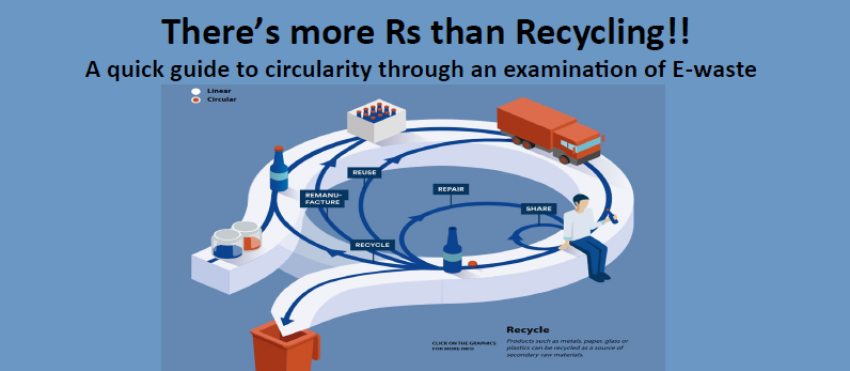
For those of us of a certain age living in the UK our education was driven by the 3Rs : Reading, wRiting and aRithmetic. The same is true of the circular economy. Typically there are again 3 : Re-use, Repair and Recycle, but as shown in the title graphic produced by the European Parliament there can be more.
In fact, we can introduce further ones, notably: Reduce, Redesign, Recover, Refurbish, Repurpose, Re-think, Refuse. Clearly the view that Circularity is all about recycling is a complete misconception. Recycling is but one facet of the circular economy and is not even the first level.
E-waste
The potential for Circularity can be demonstrated in how the world needs to deal with E-waste. The 2024 Global E-waste Monitor, produced by the UN, stated that 62Mt of e-waste was produced in 2022, up 82% from 2010, and on track to rise by another 32% to 82Mt by 2030. In 2022, a mere 22%, 13.8Mt, was col-lected and recycled in what the UN defined as an “environmentally sound manner”. It is thought that around 14Mt was simply landfilled. Globally over 40% of E-waste in Europe is recycled in formal systems, this drops to <1% in African countries.
We must Refuse to accept this and Reduce the losses from both an environmental land economic stand-point. We should potentially Rethink electronics in all its forms, Redesigning them to promote Circulatory
and Recovery at the end of life. But is a circular model really feasible?
What is E-waste?
To understand if or how E-waste can be used circularly; we need to understand what it is. In the 2024 Global E-waste Monitor, the UN defined E-waste as Electrical and Electronic Equipment (EEE) that has been discarded by its owner as waste without intent of reuse. This of course does not mean that a new owner will not reuse it. It further defines EEE as referring to all products with circuitry or electrical components and a power or battery supply. The UN reported the following breakdown of E-waste types and further break-down of that waste type being “formally” recycled.
This data is very much focused on recycling and highlights the confusion with circularity and recycling. Is this perhaps because the other options for circularity are currently not feasible. If we take a refrigerator for example. When this unit breaks in our homes, in the current throw away society that we live in means we buy a new one; possibly cheaper than the old one likely to have more features and very likely more energy efficient. There is no drive to get it repaired, who would want such a second-hand unit even if it was repaired, and, a refrigerator is always going to be a refrigerator. The best option is the unit enters a for-mal recycling system and the various constituents are recycled… to make a new refrigerator?

The IT example
For one type of E-waste there is a proven circularity and that is in IT. However, this is could well be driven by fears over data security once the unit is thrown away rather than over environmental concerns! But ITAD : IT Asset Disposition does reveal how a number of issues with obtaining circularity have been overcome.
Waste is generated in a myriad of locations and quantities, whereas an ore body is quite specifically located and sized. In the refrigerator example, it would be one unit at one home only. Thus, collection and sorting of waste is the first key step. Looking at Canada and USA, ITAD companies, such as TES, E-cycle, ERI and Sims Lifecycle Services operate well defined networks for the collection of waste electronics to keep them separated from the general waste stream. The waste is brought either by the waste generator or collected by the processor and brought to ITAD processing centres. These allow the electronic waste to be sorted and assessed to see whether it can be Repurposed, Repaired, Refurbished, or if at the end of its working life shredded for Recycling. The ITAD step in the processing of IT E-waste is critical for circularity. It avoids all such waste
being shredded and recycled without the opportunity for other stages to take place, giving both environ-mental and economic advantages.
Smelting – the final recovery of all elements in E-waste
Shredded end of life E-waste, be it from ITAD operations or other E-waste scrapping facilities, is sent to smelters to recover the values from it. However, the metals content of E-waste is not consistent, being dependent on the type of E-waste that has been processed.

This variability means that the E-waste must be carefully sampled and analysed so that the processing smelter fully understands the feed that it is dealing with. The level of copper in the material typically means it is the carrier metal and the E-waste is processed by primary and secondary copper smelters, such as Ronnskar (Boliden, Sweden), Naoshima and Onahama (Mitsubishi, Japan), Hoboken (Umicore, Belgium) and Horne (Glencore, Canada). But the key factor at all of these locations is that not just the copper is recovered, other values such as silver, golds and PGMs are also recovered and sent for further refining to ensure their full recovery.
BUT ...
There is well defined circulatory for some areas of E-waste processing. What is clear is that it needs to be expanded to ensure global coverage of all facets of E-waste, as well as increases in take-up in areas where defined systems are already in play. At the end of the day, this is not only a huge environmental benefit, the recycling stage alone was worth US$28 million in 2022 and this was for processing 22% of the total available.
But is this in fact the reality of where we are with Circularity; let’s at least get the Recycling phase fully into play?
To discuss topics raised in this article, contact John Anderson, Principal Consultant - Metallurgical Analysis at Skarn Associates
Recycling Today has also highlighted the "3R's" in its recent article: https://bit.ly/4buF0cY
Recycling International joined the conversation with its article on E-dumping and its implications on E-waste: https://lnkd.in/di7GYyAq
This Article is an exerpt from the Skarn Bulletin. The Skarn Bulletin shares original analysis from Skarn Associates and curates news and developments in the mining sector sustainability space. We welcome your ideas and comments, so please feel free to get in touch.
If you would like to raise your corporate profile with an mining sustainability focused audience whilst supporting Skarn's monthly Bulletin, sponsorship opportunities are now available. Contact Zoe Cripps, Skarn Marketing lead for details.
Never miss an update Subscribe here
MORE FROM SKARN

About Us
Skarn Associates is the market leader in quantifying and benchmarking asset-level greenhouse gas emissions, energy intensity, and water use across the mining sector.
